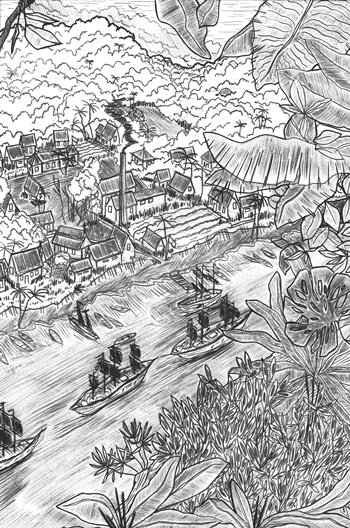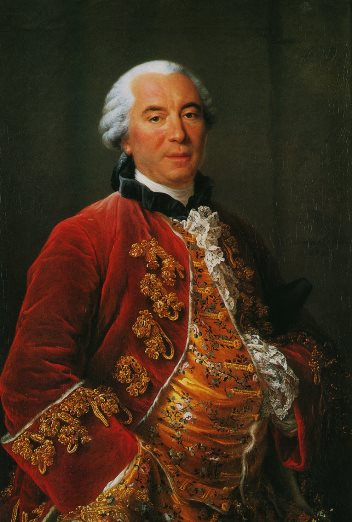 Jan Zalasiewicz and friends uncover an under-reported aspect of the great French biologist.
Jan Zalasiewicz and friends uncover an under-reported aspect of the great French biologist.
Georges-Louis Leclerc, Comte de Buffon, was in many ways emphatically a man of
France’s ancien régime. Born into solid bourgeoisie, he inherited a title and a castle as a young man. He was no pampered and idle aristocrat, though. Through a combination of talent and lifelong, sustained hard graft, he came to be placed by Louis XV in charge of both the Jardin du Roi and the Cabinet du Roi (that were to become the Botanical Gardens and Natural History Museum of Paris).
Picture: Georges-Louis Leclerc, Comte de Buffon. Portrait in oils by Francois-Hubert Drouais. Musee Buffon, Motbard. Public Domain.
Buffon showed good timing in death as in life, avoiding a likely appointment with Madame Guillotine by dying peacefully in 1788, the year before the French Revolution (his son was not so lucky). Known in his time as a savant of the Enlightenment to rival Voltaire and Diderot, his reputation today mainly rests on his explorations of biology. But it is less widely known is that he was an inspired and ground-breaking geologist too.
Odyssey
Buffon built his reputation upon a lifelong scientific odyssey - a 36-volume exploration of the natural world, his Histoire Naturelle. This work combined pioneering biological thinking with beautiful, evocative prose, provoking jealousy among his peers but building an audience that reached far beyond them. The style was no mere artifice – Buffon saw elegance of exposition and clarity of thinking as two sides of the same coin.
Buffon was deeply interested in the mysteries of the living world; but those interests extended more widely, to encompass our planet as a whole. Some volumes of the Histoire Naturelle focused on minerals as well as living organisms, and late in his life, in 1778, he penned a slim volume entitled Les Époques de la Nature (The Epochs of Nature). In this book he provided what is arguably the first scientific, evidence-based history of the Earth, from beginning to end.
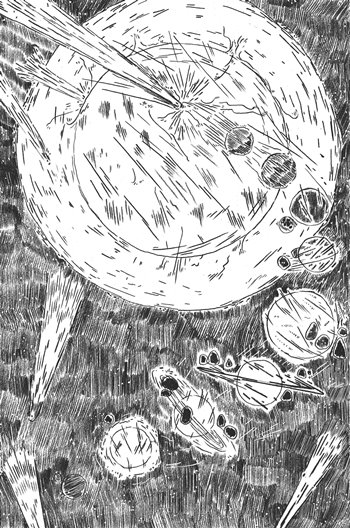 It is a remarkable work, combining large-scale scientific synthesis in vividly telling the grand-scale story of our planet as an interconnected whole from beginning to end, with vignettes of minute detail deduced from rock and fossil evidence. Its place in the history of geology has been somewhat overlooked outside the French-speaking world, not least because,only fragments of the book have ever been translated into English – a 240-year long omission that we have just remedied.
It is a remarkable work, combining large-scale scientific synthesis in vividly telling the grand-scale story of our planet as an interconnected whole from beginning to end, with vignettes of minute detail deduced from rock and fossil evidence. Its place in the history of geology has been somewhat overlooked outside the French-speaking world, not least because,only fragments of the book have ever been translated into English – a 240-year long omission that we have just remedied.
Picture, right: Anne-Sophie Milon, First Epoch, When the earth and the planets took their form.
Classical
It is an Earth history deduced in a scientific context that is now alien to us. For instance, the classical elements of Earth, air, fire and water had not yet been replaced by such as oxygen, hydrogen, silicon. And Buffon was not a global traveller in the mould of Humboldt or Darwin; his own travels were mainly restricted to the annual migration between Paris and his chateau at Montbard. Nevertheless he was a sharp observer of his own terrain, a voracious reader and diligent correspondent. For him, that was enough – the mind, he said, was the best crucible.
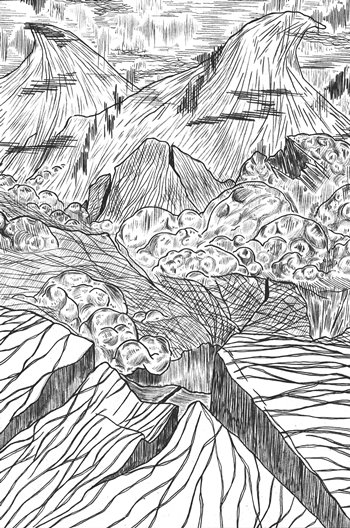
Picture, left: Anne-Sophie Milon, Second Epoch, When matter, being consolidated, formed the interior rock of the globe and the great vitrescible masses that lie on the surface.
Buffon’s Earth of Les Époques was finite: it had a beginning, and will have an end, determined by the cooling of the Earth from a molten ball torn from the Sun, to an ultimate death by freezing sometime in the future. He calculated a span to the present day experimentally, from the cooling of iron spheres taken from a furnace, and published an age of the Earth of 75,000 years. In Les Époques he alluded to this figure being unreasonably brief from the evidence of rock strata – and his notebooks show that privately he thought three million years may be nearer the mark.
But 75,000 years was still a figure that shattered the Biblical timescale, and so he carefully constructed a ‘First Discourse’ to his book, arguing that his own ideas, being ‘purely theoretical’, could not possibly harm the eternal verities of the Bible. Despite some grumbling among the clerics, the ploy mostly worked, and with that deft piece of diplomacy out of the way, Buffon simply got on with the science.
Epochs
His Earth history comprised seven epochs, the first representing a molten, spinning, cooling globe, and the last when humans appeared on the planet. In between, oceans appeared from the condensation of water vapour, primary crystalline rocks were eroded and weathered to form sedimentary rocks, volcanoes erupted, life appeared and went through different forms as the Earth cooled, and the continents took on their present-day shapes.
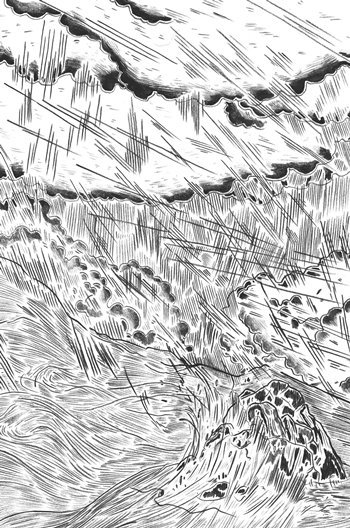
Picture, right: Anne-Sophie Milon, Third Epoch, When the waters covered the continents.
Buffon’s Earth had to be internally consistent and logical, even if he was working on a tiny – and sometimes misleading – evidence base. He posited a long-term fall in sea level to explain marine strata on land, with ocean water tumbling onto subterranean caverns left over from the solidifying Earth. Noting that active volcanoes were common near coastlines, he powered them by exothermic reactions between the inrushing seawater and buried minerals such as pyrite. Refreshingly, he presented these ideas not as incontrovertible fact, but essentially as hypotheses, for future generations of scholars to examine.
His examination of smaller-scale evidence showed that he was developing the reflexes of a field geologist. In the countryside around his Montbard estate, he deduced the three-dimensional arrangement of limestone and shale units. The limestones, he said, were the amassed remains of countless generations of shellfish, while the mudstones he saw as the weathered and decayed products of the Earth’s original crystalline rocks.
He observed the fossils that the rocks contained, such as ‘horns of Ammon’ (ammonites) and belemnites, and said that these represented kinds of animals that were no longer alive on Earth. He thus in effect put forward the phenomenon of biological extinctions, a generation – and a political revolution – before Baron Cuvier, the man more generally associated with establishing this concept in geology.
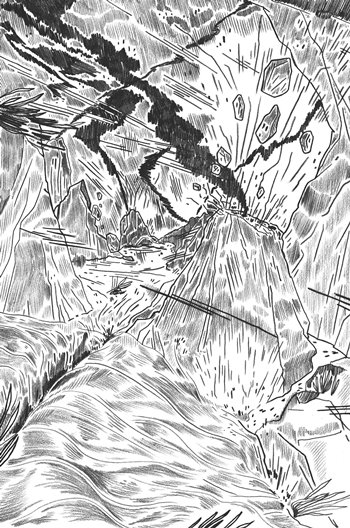 Buffon worried away at this concept, noting that the shallow sediments above the ancient rock strata contained the remains of elephants and hippotamuses – while from north America he detailed reports of bones of an animal with elephant-like tusks and huge teeth more like those of a hippo. It was a more recently vanished giant, he said, of the beast that we would come to know as the mastodon.
Buffon worried away at this concept, noting that the shallow sediments above the ancient rock strata contained the remains of elephants and hippotamuses – while from north America he detailed reports of bones of an animal with elephant-like tusks and huge teeth more like those of a hippo. It was a more recently vanished giant, he said, of the beast that we would come to know as the mastodon.
Picture, left: Anne-Sophie Milon, Fourth Epoch, When the waters retreated, and the volcanoes became active.
Palaeontology
Buffon proposed that such petrifactions should be studied and classified just as people were beginning to classify living organisms – and so foreshadowed the science of palaeontology. Though the science was yet to be established, it did not stop him making deductions from first principles. Coal seams, he proposed, were the compressed and carbonized remains of prehistoric swamp forests – and, in an inspired piece of palaeoenvironmental reconstruction, he made an overt comparison with descriptions of the extant forests of Guyana (he had never been there, but provided a vivid and atmospheric reconstruction based on travellers’ accounts).
Picture, right: Anne-Sophie Milon, Fifth Epoch, When the elephants and the other animals of the south lived in the north.
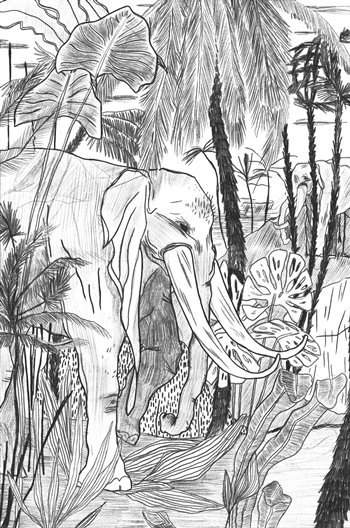 Les Époques was one of Buffon’s most widely read books in his lifetime – blessedly briefer than the erudite but enormous Histoire Naturelle, written with scientific imagination and clarity, and with something of the verve of a Conan Doyle or a Jules Verne. A fellow savant, Jean-Etienne Guettard, complained that it was an adventure story to be ‘devoured by the maidservant and amuse lackeys’ – but it was admired by Catherine the Great of Russia too, which pleased Buffon greatly. It is worth reading today, still, as one of the earliest and most impressive explorations of a vanished world.
Les Époques was one of Buffon’s most widely read books in his lifetime – blessedly briefer than the erudite but enormous Histoire Naturelle, written with scientific imagination and clarity, and with something of the verve of a Conan Doyle or a Jules Verne. A fellow savant, Jean-Etienne Guettard, complained that it was an adventure story to be ‘devoured by the maidservant and amuse lackeys’ – but it was admired by Catherine the Great of Russia too, which pleased Buffon greatly. It is worth reading today, still, as one of the earliest and most impressive explorations of a vanished world.
And, in Buffon’s description of the emerging world – his seventh epoch when humans appeared, with their powers ‘assisting’ the forces of nature – we have one of the first premonitions of the Anthropocene. Buffon, in true Enlightenment spirit, was an optimist and looked here towards a more peaceful and productive world.
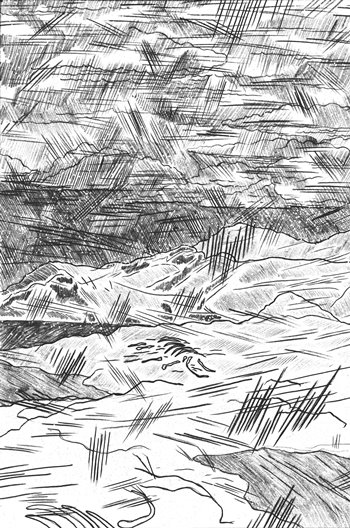 Time, in this respect, will tell.
Time, in this respect, will tell.
Authors
Jan Zalasiewicz, Anne-Sophie Milon and Mateusz Zalasiewicz. E: [email protected]
Picture, below left: Anne-Sophie Milon, Sixth Epoch, When the separation of continents was made.
Reference & acknowledgement
Buffon, Comte de, 2018. The Epochs of Nature. (Translated and compiled by Zalasiewicz, J, Milon, A-S & Zalasiewicz, M, with an Introduction by Zalasiewicz, J, Sörlin, S, Robin, L & Grinevald, J) Chicago University Press.
Including original illustrations by Anne-Sophie Milon, reproduced here by kind permission of Chicago University Press.
Image, bottom: Anne-Sophie Milon, Seventh and Last Epoch, When the power of man assisted that of nature.
